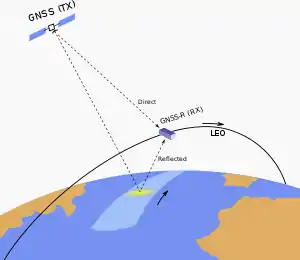GNSS reflectometry
GNSS reflectometry (or GNSS-R) involves making measurements from the reflections from the Earth of navigation signals from Global Navigation Satellite Systems such as GPS. The idea of using reflected GNSS signal for earth observation became more and more popular in the mid-1990s at NASA Langley Research Center[1] and is also known as GPS reflectometry. Research applications of GNSS-R are found in
- Altimetry [2][3]
- Oceanography (Wave Height and Wind Speed)[4]
- Cryosphere monitoring[1][5]
- Soil moisture monitoring[6]

GNSS reflectometry is passive sensing that takes advantage of and relies on separate active sources - the satellites generating the navigation signals. For this, the GNSS receiver measures the signal delay from the satellite (the pseudorange measurement) and the rate of change of the range between satellite and observer (the Doppler measurement). The surface area of the reflected GNSS signal also provides the two parameters time delay and frequency change. As a result, the Delay Doppler Map (DDM) can be obtained as GNSS-R observable. The shape and power distribution of the signal within the DDM is dictated by two reflecting surface conditions: its dielectric properties and its roughness state. Further derivation of geophysical information rely on these measurements.
GNSS reflectometry works as a bi-static radar, where transmitter and receiver are separated by a significant distance. Since in GNSS reflectometry one receiver simultaneously can track multiple transmitters (i.e. GNSS satellites), the system also has the nature of multi-static radar. The receiver of the reflected GNSS signal can be of different kinds: Ground stations, ship measurements, airplanes or satellites, like the UK-DMC satellite, part of the Disaster Monitoring Constellation built by Surrey Satellite Technology Ltd. It carried a secondary reflectometry payload that has demonstrated the feasibility of receiving and measuring GPS signals reflected from the surface of the Earth's oceans from its track in low Earth orbit to determine wave motion and windspeed.[4][7]
References
- Komjathy, A.; Maslanik, J.; Zavorotny, V.U.; Axelrad, P.; Katzberg, S.J. (2000). "Sea ice remote sensing using surface reflected GPS signals". IGARSS 2000. IEEE 2000 International Geoscience and Remote Sensing Symposium. Taking the Pulse of the Planet: The Role of Remote Sensing in Managing the Environment. Proceedings (Cat. No.00CH37120). Vol. 7. Honolulu, HI, USA: IEEE. pp. 2855–2857. doi:10.1109/IGARSS.2000.860270. hdl:2060/20020004347. ISBN 978-0-7803-6359-5. S2CID 62042731.
- Semmling, A. M.; Wickert, J.; Schön, S.; Stosius, R.; Markgraf, M.; Gerber, T.; Ge, M.; Beyerle, G. (2013-07-15). "A zeppelin experiment to study airborne altimetry using specular Global Navigation Satellite System reflections: A ZEPPELIN EXPERIMENT TO STUDY AIRBORNE ALTIMETRY". Radio Science. 48 (4): 427–440. doi:10.1002/rds.20049.
- Rius, Antonio; Cardellach, Estel; Fabra, Fran; Li, Weiqiang; Ribó, Serni; Hernández-Pajares, Manuel (2017). "Feasibility of GNSS-R Ice Sheet Altimetry in Greenland Using TDS-1". Remote Sensing. 9 (7): 742. Bibcode:2017RemS....9..742R. doi:10.3390/rs9070742. ISSN 2072-4292.
- Gleason, S.; Hodgart, S.; Yiping Sun; Gommenginger, C.; MacKin, S.; Adjrad, M.; Unwin, M. (2005). "Detection and Processing of bistatically reflected GPS signals from low Earth orbit for the purpose of ocean remote sensing". IEEE Transactions on Geoscience and Remote Sensing. 43 (6): 1229–1241. Bibcode:2005ITGRS..43.1229G. doi:10.1109/TGRS.2005.845643. S2CID 6851145.
- Rivas, M.B.; Maslanik, J.A.; Axelrad, P. (2009-09-22). "Bistatic Scattering of GPS Signals Off Arctic Sea Ice". IEEE Transactions on Geoscience and Remote Sensing. 48 (3): 1548–1553. doi:10.1109/tgrs.2009.2029342. ISSN 0196-2892. S2CID 12668682.
- Rodriguez-Alvarez, Nereida; Camps, Adriano; Vall-llossera, Mercè; Bosch-Lluis, Xavier; Monerris, Alessandra; Ramos-Perez, Isaac; Valencia, Enric; Marchan-Hernandez, Juan Fernando; Martinez-Fernandez, Jose; Baroncini-Turricchia, Guido; Perez-Gutierrez, Carlos (2011). "Land Geophysical Parameters Retrieval Using the Interference Pattern GNSS-R Technique". IEEE Transactions on Geoscience and Remote Sensing. 49 (1): 71–84. Bibcode:2011ITGRS..49...71R. doi:10.1109/TGRS.2010.2049023. ISSN 0196-2892. S2CID 27516781.
- M. P. Clarizia et al., Analysis of GNSS-R delay-Doppler maps from the UK-DMC satellite over the ocean Archived 2011-06-06 at the Wayback Machine, Geophysical Research Letters, 29 January 2009.
Further reading
- Zavorotny, Valery U.; Gleason, Scott; Cardellach, Estel; Camps, Adriano (2014). "Tutorial on Remote Sensing Using GNSS Bistatic Radar of Opportunity". IEEE Geoscience and Remote Sensing Magazine. Vol. 2, no. 4. pp. 8–45. doi:10.1109/MGRS.2014.2374220. ISSN 2168-6831.
- Larson, Kristine M.; Small, Eric E.; Braun, John; Zavorotny, Valery (2014). "Environmental Sensing: A Revolution in GNSS Applications". InsideGNSS. Vol. 9, no. 4. pp. 36–46. ISSN 1559-503X. Archived from the original on 2016-03-15. Retrieved 2016-03-15.
- Cardellach, Estel (2015): E-GEM – GNSS-R Earth Monitoring; State of the Art Description Document Archived 2020-11-28 at the Wayback Machine.
- Emery, William and Camps, Adriano (2017): Introduction to Satellite Remote Sensing 1st Edition Atmosphere, Ocean, Land and Cryosphere Applications, Chapter 6: Remote Sensing Using Global Navigation Satellite System Signals of Opportunity, Elsevier, 20th September 2017, Paperback ISBN 9780128092545, eBook ISBN 9780128092590
- A complete list of references maintained by the GNSS-R Community can be found at: https://www.ice.csic.es/personal/rius/gnss_r_bibliography/index.html
External links
- Reflecting on the future Archived 2007-05-14 at the Wayback Machine, The Engineer Online, 28 November 2006.
- GNSS Applications and Methods, Artech House, September 2009.